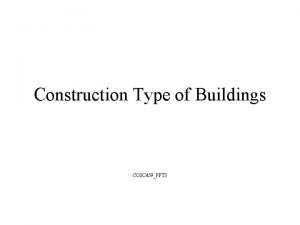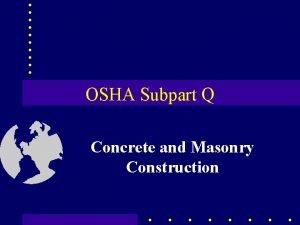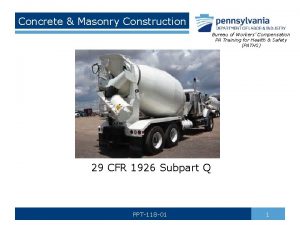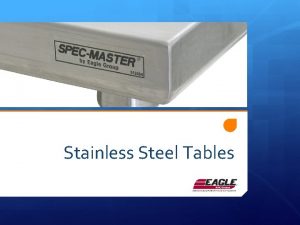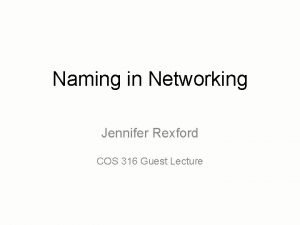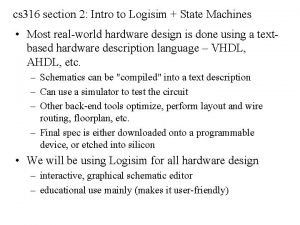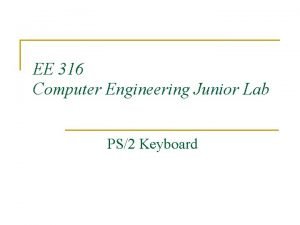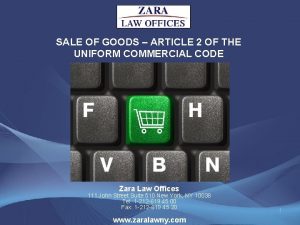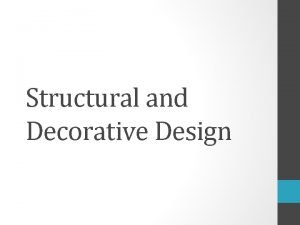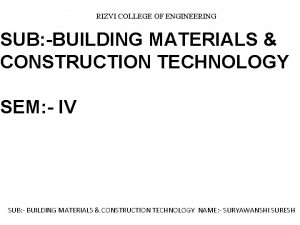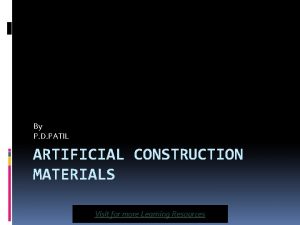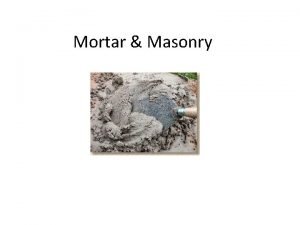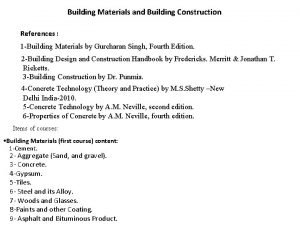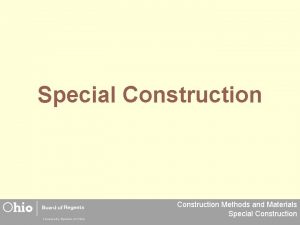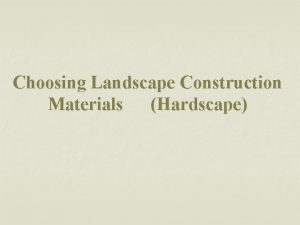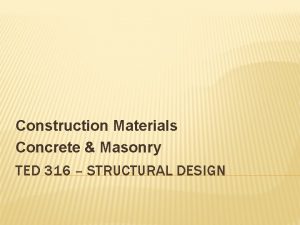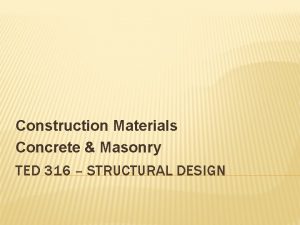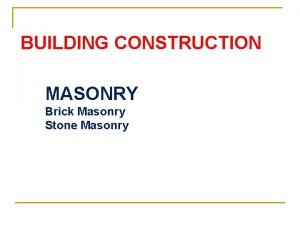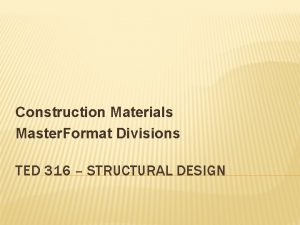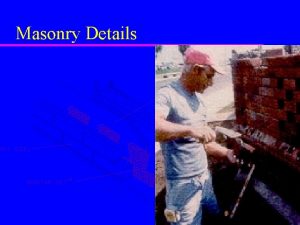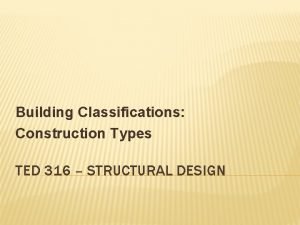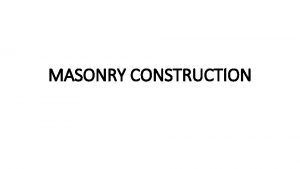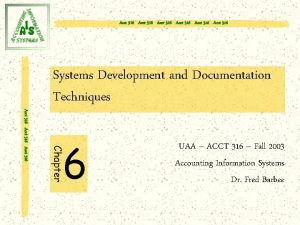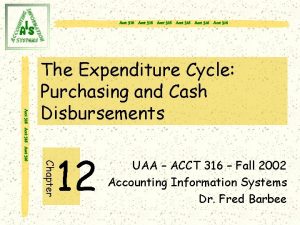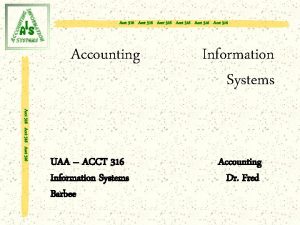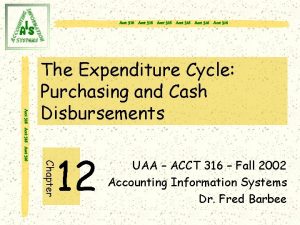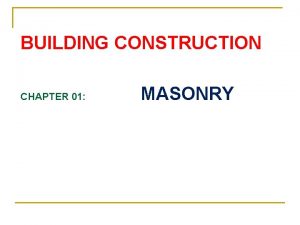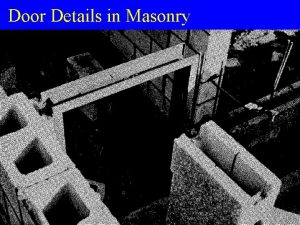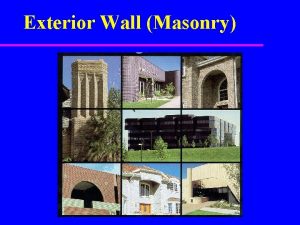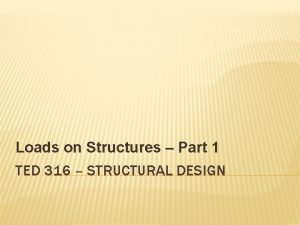Construction Materials Masonry TED 316 STRUCTURAL DESIGN MASONRY




















- Slides: 20

Construction Materials Masonry TED 316 – STRUCTURAL DESIGN

MASONRY � Building of structures from individual units � Common materials: � Brick � Stone � Marble � Granite � Concrete block � Glass block

MASONRY APPLICATIONS � Walls of buildings � Retaining walls � Monuments � Brick and block are most commonly used � Can be weight bearing or veneer � Rebar is added to increase tensile and lateral strength

MASONRY - ADVANTAGES � Increase thermal mass � Does not require painting � Heat and fire resistance � High impact resistance � Long life-cycle

MASONRY - DISADVANTAGES � Degradation due to frost damage � Requires a strong foundation � Heavy

MASONRY – STRUCTURAL LIMITATIONS � Good compressive strength � Much lower tensile strength � Reinforcement needed � Thickening wall � Masonry piers � Steel reinforcement

MASONRY - VENEER � Masonry units installed on one or both sides of a structurally independent wall � Decorative not structural � Common materials � Brick � Stone � Attached with brick ties

MASONRY - VENEER � Air gap � Waterproofing � Water-resistant � Weep � Interior surface holes insulation � Fiberglass for stud walls � Foam board for block � Takes advantage of thermal mass

DRY SET MASONRY (DRY STONE) � Building material – mortar bond not critical � Friction provides strength � Grooves and keys add strength � Mortar-less masonry

SOLID MASONRY � Economical � Limited applications � Low � Thick � Susceptible to earthquakes � Reinforcement needed

STONE � Commonly used � Granite � Slate � Limestone � Sandstone � Marble

STONE � Common forms � Crushed � Sand � Pea gravel � Rip rap � Fieldstone � Dimensional stone � Rubble � Flagstone

STONE � Characteristics � Strength � High compression � Low tension � Hardness – varies � Workability – relates to hardness � Durability � Appearance � Accessibility � Indigenous

BRICK � Categories � Sun-dried bricks � Kiln burned bricks � Building bricks � Refractory bricks

BRICK � Types � Common brick � Face brick � Glazed face brick � Fire brick � Sand lime brick � Special brick � Paving brick � Omni brick � Sculpted brick

BRICK � Two or more layers � Horizontal rows (stretcher bricks) � Cross ties (header bricks) � Bonds (pattern of stretcher and header) � Common � English and Flemish � Staggered vs. non-staggered

BRICK – UNIFORMITY AND RUSTICITY � Wide variety of styles and types � 1950 s-1970 s: consistency = sterile � 1980 s on: move back to rustic look � Burnt bricks � Salvage bricks � Aged new bricks � Free, artistic style

BLOCKS � Cinder blocks � Concrete blocks � Hollow tile � Generically referred to as Concrete Masonry Units (CMUs) � Larger than bricks � Faster to lay � Lower water absorption rates than bricks

BLOCK � Used as structural core for veneer walls � Used alone where appearance is not critical � Stucco covering � Decoration � Extra strength � Pre-colored or stained � Reinforcement � Bond beam � Filling hollow voids � Rebar and ladder-reinforcement

GLASS BLOCK � Made of glass � Structural or appearance � Provide light and/or view
 Joisted masonry
Joisted masonry Limited access zone
Limited access zone Limited access zones around masonry wall construction
Limited access zones around masonry wall construction Type 316 stainless steel tables
Type 316 stainless steel tables Princeton cos 316
Princeton cos 316 Cs 316
Cs 316 316 loài vẹt
316 loài vẹt Ee 316
Ee 316 Ee-316
Ee-316 Ucc 2-703
Ucc 2-703 Structural design in fashion
Structural design in fashion Classification of decorative design
Classification of decorative design Construction materials names and pictures
Construction materials names and pictures Artificial construction material
Artificial construction material What is gauged mortar
What is gauged mortar References on building construction
References on building construction Special construction examples
Special construction examples Landscape construction materials
Landscape construction materials Favourite cars
Favourite cars Example of useful and harmful
Example of useful and harmful Natural man made
Natural man made
